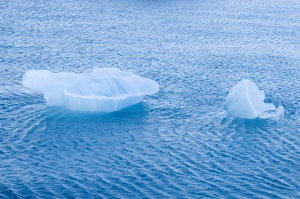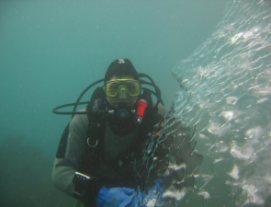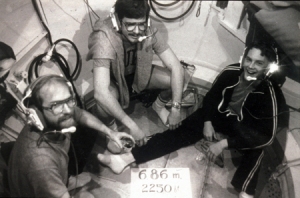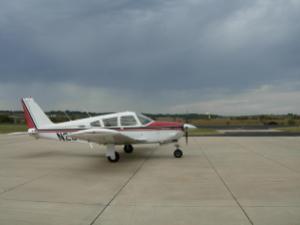 I was securely strapped into one of the world’s largest human centrifuges at the Naval Air Development Center (NADC) Warminster, Pennsylvania, jocked-down like a pilot in a high performance fighter. As the gondola started moving, I felt the pneumatic cushions in my G-suit inflate, squeezing my legs and abdomen, helping to prevent blood from pooling. Excess pooling would cause a decrease in the volume of blood being pumped to my brain, potentially resulting in unconsciousness. That type of blackout is called G-LOC, or G-induced loss of consciousness.
I was securely strapped into one of the world’s largest human centrifuges at the Naval Air Development Center (NADC) Warminster, Pennsylvania, jocked-down like a pilot in a high performance fighter. As the gondola started moving, I felt the pneumatic cushions in my G-suit inflate, squeezing my legs and abdomen, helping to prevent blood from pooling. Excess pooling would cause a decrease in the volume of blood being pumped to my brain, potentially resulting in unconsciousness. That type of blackout is called G-LOC, or G-induced loss of consciousness.
G is the term for the acceleration of gravity, about 9.8 m/s2. I was being exposed to a relatively mild but prolonged 3-Gs. To put that acceleration into perspective, the shuttle astronauts are exposed to no more than 3-Gs near the end of their climb to orbit, and briefly during reentry. The Apollo astronauts headed to the moon were limited to a maximum of 4 Gs, again during only a brief period of time.
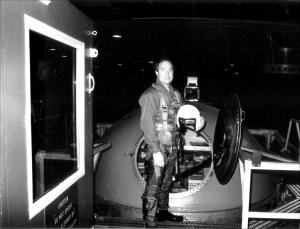
But my three-G exposure was not brief. If I had been launched upwards with a 3-G acceleration for three minutes I would have been travelling at almost 12,000 miles per hour at the end of those 3-minutes, over mach 15, and would have climbed 296 miles, well above the altitude of the International Space Station. It would have been a sight to behold.
Another 3 and a half minutes and I would have been going fast enough to escape Earth’s gravity.
Alas, in reality I wasn’t going anywhere, except in circles around the inside of the centrifuge room, attached to a 4000 hp electric motor by a 50-foot long arm.
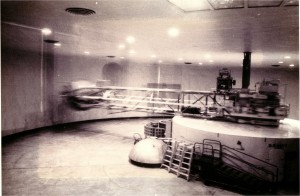
During the run I experienced about what I’d expected — I felt heavy, very heavy, like 3 times my body weight heavy. But I was not at all expecting the sensation I got when they put on the brakes. I felt like a bowling ball careening down a bowling lane. I felt like a gymnast doing impossibly fast forward somersaults.
It was not pleasant.
And I’m very glad the photographer took a photo before the run, rather than after.
I was at Warminster to study the stresses imposed on F/A-18 fighter pilots during high-G exposures. In the 1990s, losses of aircraft and pilots were an all too frequent occurrence during high-speed maneuvering flight due to G-LOC. To prevent G-LOC pilots need to perform, with precision, an anti-G straining manuever, even though they wear the same anti-G suit I was wearing.

To understand the fighter pilots’ problems, anti G-suits provide at most 1-1.5 G protection advantage. and most people lose consciousness above 3-5 Gs without a G-suit. But a fighter like the F/A-18 can easily pull 8-9 Gs during close in combat. That is where the anti-G straining manuever comes in. The pilots grunt and strain, contracting their leg and abdominal muscles during the high-G portion of the pull, forcing blood from their abdomen into their chest cavity, making blood available for the heart and brain.

The NADC centrifuge had been used to train the Mercury, Gemini, and Apollo astronauts. Quoting from the Air & Space Smithsonian magazine, “John Glenn called it a “dreaded” and “sadistic” part of astronaut training. Apollo 11’s Michael Collins called it “diabolical.” Time magazine referred to it as “a monstrous apparatus,” a “gruesome merry-go-round,” and, less originally, a “torture chamber.”
http://www.airspacemag.com/history-of-flight/the_g_machine.html
Compared to the centrifuge ride, a flight to the moon was a cake-walk, except for Apollo 13 of course.
The NADC centrifuge was closed by the BRAC committee in 1996. The Navy Aerospace Medical Research Laboratory in Pensacola FL also has a centrifuge in which I’ve ridden, but NAMRL is closing as well, in September 2011.
It seems like military man-rated centrifuges aren’t as popular as they used to be.

Fortunately, NASA has a modern centrifuge, although its maximum G-force capability is about half that of the NADC centrifuge.  Nevertheless, anyone who has ridden a centrifuge will tell you the 20-G capability of the NASA Ames centrifuge is more than enough to test human endurance to the forces of acceleration.
Nevertheless, anyone who has ridden a centrifuge will tell you the 20-G capability of the NASA Ames centrifuge is more than enough to test human endurance to the forces of acceleration.













